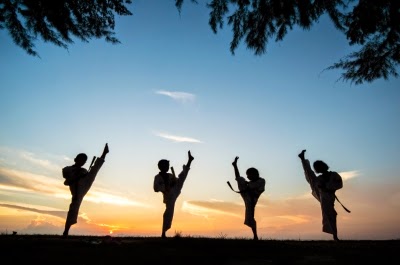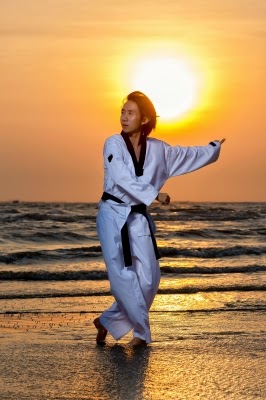As a parent of a child diagnosed on the Autism spectrum, I can relate in a different way and on a difference scale to those people looking for activities to get their child involved with that won’t cause them to feel ostracized, not able to keep up with peers, or like they are frustrating the instructors. Will little Johnny be made fun of? Will he be too much of a distraction for the others in the activity? Will Jane feel too badly about herself if she can’t do what the others can and keep up in the same way? Yep, I have asked myself the same questions as I considered what I could do to help my child become a more well rounded, self confident, positive contributing member of society. And, whether you or your child have physical, emotional, or mental disabilities, all can feel the discomfort associated with self doubt and putting one’s self or someone you love in harms way. The disability is hard enough to contend with, adding the stress of how others react to it can also, at times, do its own damage.
I know for me, my son’s own struggles were more clearly evident in social settings. I was looking for an activity that would force him have to interact with peers as well as something that might assist with helping him to learn more focus because he also struggled with ADHD. As I did more research, I found that while there were many wonderful activities available to youngsters and adults alike, Martial Arts seemed like the best fit by far for a number of poignant reasons.
Martial Arts Benefits for the Disabled… or anyone!
It’s a great way to get exercise!
To begin with the obvious, it was nice to know that getting my son involved in martial arts as a way to get some much needed exercise would help him with stamina, flexibility, and strength. What I didn’t anticipate but happily found was that he quickly became much more coordinated. For those people that are dealing with a physical disability, the physical therapy they often undergo to increase strength and flexibility in their limbs is mimicked in some ways with the strict stretching regimen most martial arts schools have their students perform before starting class as well as the repetitive kicking, punching, holding, and blocking techniques they are required to learn in getting a base set of skills to learn how to properly defend themselves. These movements, over time, promote increased strength and coordination.
Need a Dose of Self Confidence Anyone?
Another wonderful benefit of martial arts is that in virtually every discipline offered, masters and instructors core curriculum includes exercises and teaching that helps to build leadership skills and self confidence. Students are learning in a praise rich environment where student and instructor are often being asked to look for the positive each effort given, whether correction is given or not. As kids begin to recognize that there are many things do well and see themselves progress, parents and peers often remark at how an inner self confidence begins to emerge evidenced by their child becoming more social in situations where they were often very shy and eluding to more friendships developing in their social circles.
The value of learning how to focus!
Having two children that struggle with ADHD and having endured it myself all these years, I can honestly say that finding anything non pharmaceutical that aids in helping a person to better focus on achieving goals and getting through tasks is a valuable tool indeed!
What does R-E-S-P-E-C-T mean?
To those in the martial arts, respect means a lot of things. It means showing instructors and elders a sense of appreciation for their efforts to teach. It also means showing their fellow students and competitors recognition for their effort and achievement. Students are often taught many ways to show respect to others in life in how they carry themselves. In martial arts class, students learn how being quiet and waiting patiently for another to finish speaking is a way of showing leadership and respect. Among other things, they are taught that always trying their hardest is also a way of showing themselves and their instructors respect. Making sure raise your hand before asking a question, saying thank you sir or ma’am to your instructor, parent, or other adult as a way of addressing them and showing appreciation is a way of displaying respect. You will be surprised at how much more polite your child might become once enrolled in a karate class.
Yes, but how will they be able to do this with my kid since he/she is different?
One of the things that makes martial arts training more unique, as an activity to consider, than some others might be, and more effective as a result, is that many martial arts organizations have recognized the benefits of training for all and especially for those with disabilities. Because of this, there are a number of organizations that have offered instructors of their discipline specialized training in how to teach people with specific types of disabilities, whether they be cognitive or physical. There are often different techniques used to teach someone with impaired mobility, or lower cognitive function and certainly different techniques used to teach people with short attention spans. Such instructors have been trained in proven techniques that have helped their students reach into potential they didn’t even realize they had. You can learn more about some of these techniques at
Martial Arts Training for the Disabled and
Adaptive Martial Arts.
How will I know it is working?
Most students and parents of students note marked differences in themselves or their children shortly after martial arts training begins. Beyond the obvious increase in stamina, flexibility, and strength experienced, people have best described the personality changes noticed as a “coming out of ones shell”. I the case of my son, he stepped into an entire class of “misfit toys” and fit right in. Most of the children in his beginning karate class were a little quirky in their own way. They all observed the constant and continuous praise each student was receiving and were part of the celebration and clapping at the progress made by each. They were all trained at the same time on the many ways to show their fellow students and instructors respect. And they seemed to become closer for it with each passing class. As my son made many friends in his karate class and was forced into more and more interactions that required he communicate and do so in somewhat controlled conditions, he began to get better at it and find that his presence was enjoyed by his peer group. Once this happened it began to happen for him in his school setting as well. And I, well I just smiled a lot more at seeing my son actually had made some new friends that enjoyed spending time with him. Many parents have trouble relating to how much of an achievement that might be, but to me, and to my son, it was absolutely priceless.
How do I get myself or child enrolled in one of these martial arts schools?
Well you need to first find a school near you that offers the sort of martial arts you think would be best for you or your child. You can learn more about different types of martial arts disciplines
here. You also will want to contact the school to make sure they have specialized training in teaching students with the specific sort of disability you or your child have. There are many good questions to ask that will help you know that the school you are considering might be a good fit for you. You can learn more about the best questions to ask and what to look for in a good martial arts school, please visit
Find the Right Martial Arts School for You. And finally, to begin searching for a martial arts school near you please visit
Find A School and begin your wonderful journey today.
Written by Mara Rudolph Fineshriber
Mother of a 10 year old first degree black belt in Taekwondo
 master.
master. classes that are teaching you a watered down, even lazy version of the particular form of martial art you've chosen. The skills you acquire and the physical feats you achieve simply could not measure up to a student who is learning from a genuine master. Even if you have a black belt, you wouldn't stand a chance against someone half your age with the same belt.
classes that are teaching you a watered down, even lazy version of the particular form of martial art you've chosen. The skills you acquire and the physical feats you achieve simply could not measure up to a student who is learning from a genuine master. Even if you have a black belt, you wouldn't stand a chance against someone half your age with the same belt. by its cover," but it's worth taking into consideration, especially if have noticed other suspicious signs. What does a true martial arts instructor or master look like? Well, sure, you can hope for an ancient Japanese dude with a beard, but chances are you won't get him. A rule of thumb is this…
by its cover," but it's worth taking into consideration, especially if have noticed other suspicious signs. What does a true martial arts instructor or master look like? Well, sure, you can hope for an ancient Japanese dude with a beard, but chances are you won't get him. A rule of thumb is this… are aimed at increasing fitness, while making their students feel like they're actually learning a martial art don't typically include much physical combat. A true martial arts class will have students learning a great variety of moves, maneuvers and combat techniques, which they practice on each other (obviously using mild force.) McDojos tend to specialize in classes with very little physical contact between students and with no grappling or fighting being practiced.
are aimed at increasing fitness, while making their students feel like they're actually learning a martial art don't typically include much physical combat. A true martial arts class will have students learning a great variety of moves, maneuvers and combat techniques, which they practice on each other (obviously using mild force.) McDojos tend to specialize in classes with very little physical contact between students and with no grappling or fighting being practiced. codes revered and upheld by true martial arts masters. Rather what they teach is a vastly "watered down" version of the original form and while you think you are learning the skills necessary to defend yourself, in a real life context, you're likely to get your lights punched out.
codes revered and upheld by true martial arts masters. Rather what they teach is a vastly "watered down" version of the original form and while you think you are learning the skills necessary to defend yourself, in a real life context, you're likely to get your lights punched out. children holding the same colored belts as their instructor, there's something fishy going on. Mastering a martial art takes many years of dedicated practice and several hours per day honing your skills. It requires discipline, application and dedication. True masters of martial arts - those who hold real black belts – have dedicated their lives to learning and practicing.
children holding the same colored belts as their instructor, there's something fishy going on. Mastering a martial art takes many years of dedicated practice and several hours per day honing your skills. It requires discipline, application and dedication. True masters of martial arts - those who hold real black belts – have dedicated their lives to learning and practicing.
 minute class that, using martial arts inspired moves and maneuvers, will give you a killer whole body workout. It's also way more fun! But just because it may be advertised as "capoeira class" or "krav maga workout" or "kickboxing" doesn't mean you are actually going to master these martial art disciplines.
minute class that, using martial arts inspired moves and maneuvers, will give you a killer whole body workout. It's also way more fun! But just because it may be advertised as "capoeira class" or "krav maga workout" or "kickboxing" doesn't mean you are actually going to master these martial art disciplines. experienced or inexperienced you are, you should have the opportunity to compete.
experienced or inexperienced you are, you should have the opportunity to compete. students through their lives and to gently influence absolutely everything they do, from their actions and choices to the very foundations of their decision-making.
students through their lives and to gently influence absolutely everything they do, from their actions and choices to the very foundations of their decision-making.